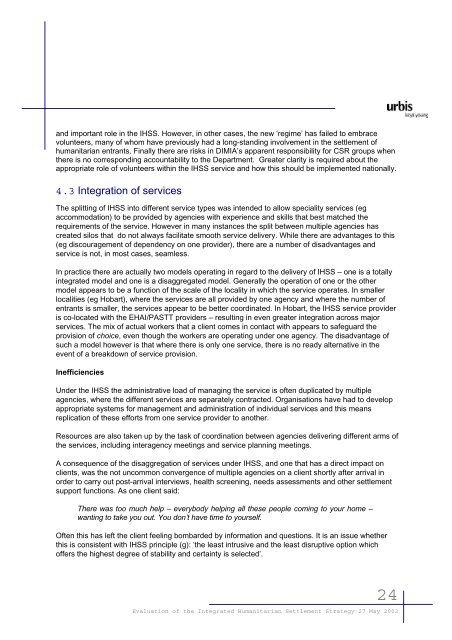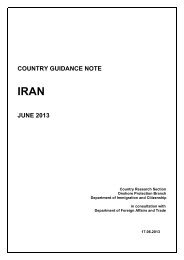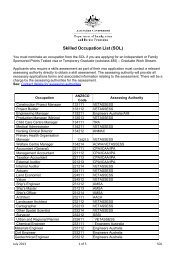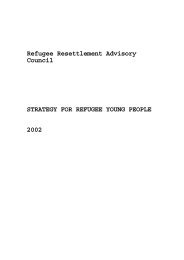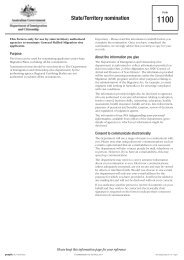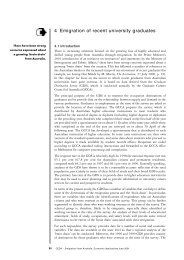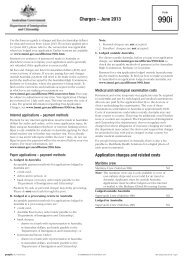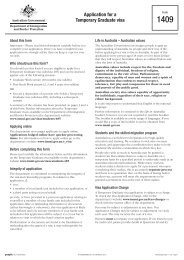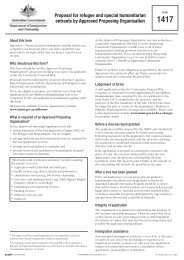Evaluation of the Integrated Humanitarian Settlement Strategy (IHSS)
Evaluation of the Integrated Humanitarian Settlement Strategy (IHSS)
Evaluation of the Integrated Humanitarian Settlement Strategy (IHSS)
Create successful ePaper yourself
Turn your PDF publications into a flip-book with our unique Google optimized e-Paper software.
and important role in <strong>the</strong> <strong>IHSS</strong>. However, in o<strong>the</strong>r cases, <strong>the</strong> new ‘regime’ has failed to embrace<br />
volunteers, many <strong>of</strong> whom have previously had a long-standing involvement in <strong>the</strong> settlement <strong>of</strong><br />
humanitarian entrants. Finally <strong>the</strong>re are risks in DIMIA’s apparent responsibility for CSR groups when<br />
<strong>the</strong>re is no corresponding accountability to <strong>the</strong> Department. Greater clarity is required about <strong>the</strong><br />
appropriate role <strong>of</strong> volunteers within <strong>the</strong> <strong>IHSS</strong> service and how this should be implemented nationally.<br />
4.3 Integration <strong>of</strong> services<br />
The splitting <strong>of</strong> <strong>IHSS</strong> into different service types was intended to allow speciality services (eg<br />
accommodation) to be provided by agencies with experience and skills that best matched <strong>the</strong><br />
requirements <strong>of</strong> <strong>the</strong> service. However in many instances <strong>the</strong> split between multiple agencies has<br />
created silos that do not always facilitate smooth service delivery. While <strong>the</strong>re are advantages to this<br />
(eg discouragement <strong>of</strong> dependency on one provider), <strong>the</strong>re are a number <strong>of</strong> disadvantages and<br />
service is not, in most cases, seamless.<br />
In practice <strong>the</strong>re are actually two models operating in regard to <strong>the</strong> delivery <strong>of</strong> <strong>IHSS</strong> – one is a totally<br />
integrated model and one is a disaggregated model. Generally <strong>the</strong> operation <strong>of</strong> one or <strong>the</strong> o<strong>the</strong>r<br />
model appears to be a function <strong>of</strong> <strong>the</strong> scale <strong>of</strong> <strong>the</strong> locality in which <strong>the</strong> service operates. In smaller<br />
localities (eg Hobart), where <strong>the</strong> services are all provided by one agency and where <strong>the</strong> number <strong>of</strong><br />
entrants is smaller, <strong>the</strong> services appear to be better coordinated. In Hobart, <strong>the</strong> <strong>IHSS</strong> service provider<br />
is co-located with <strong>the</strong> EHAI/PASTT providers – resulting in even greater integration across major<br />
services. The mix <strong>of</strong> actual workers that a client comes in contact with appears to safeguard <strong>the</strong><br />
provision <strong>of</strong> choice, even though <strong>the</strong> workers are operating under one agency. The disadvantage <strong>of</strong><br />
such a model however is that where <strong>the</strong>re is only one service, <strong>the</strong>re is no ready alternative in <strong>the</strong><br />
event <strong>of</strong> a breakdown <strong>of</strong> service provision.<br />
Inefficiencies<br />
Under <strong>the</strong> <strong>IHSS</strong> <strong>the</strong> administrative load <strong>of</strong> managing <strong>the</strong> service is <strong>of</strong>ten duplicated by multiple<br />
agencies, where <strong>the</strong> different services are separately contracted. Organisations have had to develop<br />
appropriate systems for management and administration <strong>of</strong> individual services and this means<br />
replication <strong>of</strong> <strong>the</strong>se efforts from one service provider to ano<strong>the</strong>r.<br />
Resources are also taken up by <strong>the</strong> task <strong>of</strong> coordination between agencies delivering different arms <strong>of</strong><br />
<strong>the</strong> services, including interagency meetings and service planning meetings.<br />
A consequence <strong>of</strong> <strong>the</strong> disaggregation <strong>of</strong> services under <strong>IHSS</strong>, and one that has a direct impact on<br />
clients, was <strong>the</strong> not uncommon convergence <strong>of</strong> multiple agencies on a client shortly after arrival in<br />
order to carry out post-arrival interviews, health screening, needs assessments and o<strong>the</strong>r settlement<br />
support functions. As one client said:<br />
There was too much help – everybody helping all <strong>the</strong>se people coming to your home –<br />
wanting to take you out. You don’t have time to yourself.<br />
Often this has left <strong>the</strong> client feeling bombarded by information and questions. It is an issue whe<strong>the</strong>r<br />
this is consistent with <strong>IHSS</strong> principle (g): ‘<strong>the</strong> least intrusive and <strong>the</strong> least disruptive option which<br />
<strong>of</strong>fers <strong>the</strong> highest degree <strong>of</strong> stability and certainty is selected’.<br />
24<br />
<strong>Evaluation</strong> <strong>of</strong> <strong>the</strong> <strong>Integrated</strong> <strong>Humanitarian</strong> <strong>Settlement</strong> <strong>Strategy</strong> 27 May 2003


